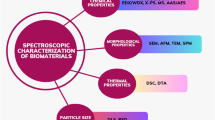We compared in vitro degradation and physical properties of polypropylene and a biodegradable polymer synthesized by electrospinning and consisting of 65% polycaprolactone and 35% polytrimethylene carbonate as a possible alternative material for use in surgery for pelvic floor muscle failure. Samples of the studied polymers were implanted to 10 male Wistar rats into the interfascial space on the back (polypropylene on the right side and biodegradable polymer on the left side). The synthesized biopolymer was characterized by elongation and tear resistance, similar to those of polypropylene. During the period from the third to the sixth month after implantation, the area of fibrosis around individual polypropylene and biopolymer fibers increased by 16.7 and 107.9%, respectively, while remaining reduced compared to polypropylene. The total fibrosis area in 6 months after implantation of polypropylene and biopolymer samples significantly increased by 18% (p=0.0097) and 48% (p=0.05), respectively, i.e. fibrosing processes were more intense in case of biopolymer. Induction of more pronounced fibrosis can be an advantage of the synthesized biopolymer when choosing the material for fabrication of implants and their use for correction of incompetence of the ligamentous and muscular apparatus.
Similar content being viewed by others
References
Bezhenar VF, Bogatyreva EV, Tscipurdeeva AA, Tsculadze LK, Rusina EI, Guseva ES. New possibilities of surgical correction of pop with use of synthetic implants: ways of preventive postoperative complications. Akush., Gin. Reprod. 2012;6(2):6-13. Russian.
Volova TG, Shishatskaya EI, Mironova PV. Materials for medicine and for cell and tissue engineering. Krasnoyarsk, 2009. Russian.
GOST R ISO 13781-2011. Resins and molded elements based on poly (L-lactide) for surgical implants. In Vitro Analysis of Degradation. Moscow, 2011. Russian.
Kalmin OV, Nikol’skii VI, Fedorova MG, Titova EV, Yangurazova EV. Morphological changes in tissues in the area of surgery after implantation of xenopericardium with a polypropylene mesh at different terms after surgery. Saratovsk. Nauch.-Med. Zh. 2012;8(4):1008-1012. Russian.
Kudasova EO, Vlasova LF, Semenov DE, Lushnikova EL. Comparative Analysis of Structural Responses of Rat Subcutaneous Fat on the Implantation of Samples of Polymethyl Methacrylate with Hydrophobic and Hydrophilic Surface. Bull. Exp. Biol. Med. 2017;162(5):687-689. https://doi.org/10.1007/s10517-017-3688-z
Kuznetsov DV, Ilinykh IA, Cherdyntsev VV, Muratov DS, Shatrova NV, Burmistrov IN. Study of UV-stability of polypropylene-based composites. Sovremen. Problemy Nauki Obrzovaniya. 2012;(6):33. Russian.
Mamedov RA. Morphological assessment of the local reaction of the body when using mesh materials for plastic of the anterior abdominal wall. Novosti Khirurgii. 2013;21(1):23-28. Russian.
Nasonova MV, Luzgarev SV, Burago AY, Doronina NV, Ezhov VA, Kudryavtseva YA. Tissue reaction on the implantation of various biodegradable membranes in the experiment. Sib. Med. Zh. (Irkutsk). 2013;119(4):63-67. Russian.
Sergeeva NS, Sviridova IK, Frank GA, Kirsanova VA, Akhmedova SA, Popov AA. Criteria of biocompatibility of materials for bone defect repair. Bull. Exp. Biol. Med. 2014;157(5):689-94. https://doi.org/10.1007/s10517-014-2644-4
Shishkova DK, Nasonova MV, Kudryavtseva YuA. Investigation of biodegradable scaffolds for cardiovascular surgery. Sib. Med. Zh. (Tomsk). 2016;31(2):116-119. Russian.
Shtilman MI. Biodegradation of polymers. Zh. Sib. Fed. Univer. Ser.: Biologiya. 2015;8(2):113-130. Russian.
Babu RP, O’Connor K, Seeram R. Current progress on biobased polymers and their future trends. Prog. Biomater. 2013;2(1):8. https://doi.org/10.1186/2194-0517-2-8
Maldonado PA, Wai CY. Pelvic organ prolapse: new concepts in pelvic floor anatomy. Obstet. Gynecol. Clin. North Am. 2016;43(1):15-26.
Neymeyer J, Moldovan DE, Miller K, Weinberger S. Female urology: review of the development in the past 5 decades. Actuelle Urol. 2019;50(1):39-55.
Author information
Authors and Affiliations
Corresponding author
Additional information
Translated from Byulleten’ Eksperimental’noi Biologii i Meditsiny, Vol. 170, No. 7, pp. 106-111, July, 2020
Rights and permissions
About this article
Cite this article
Eisenakh, I.A., Bondarev, O.I., Mozes, V.G. et al. Features of In Vitro Degradation and Physical Properties of a Biopolymer and In Vivo Tissue Reactions in Comparison with Polypropylene. Bull Exp Biol Med 170, 88–92 (2020). https://doi.org/10.1007/s10517-020-05010-5
Received:
Published:
Issue Date:
DOI: https://doi.org/10.1007/s10517-020-05010-5




